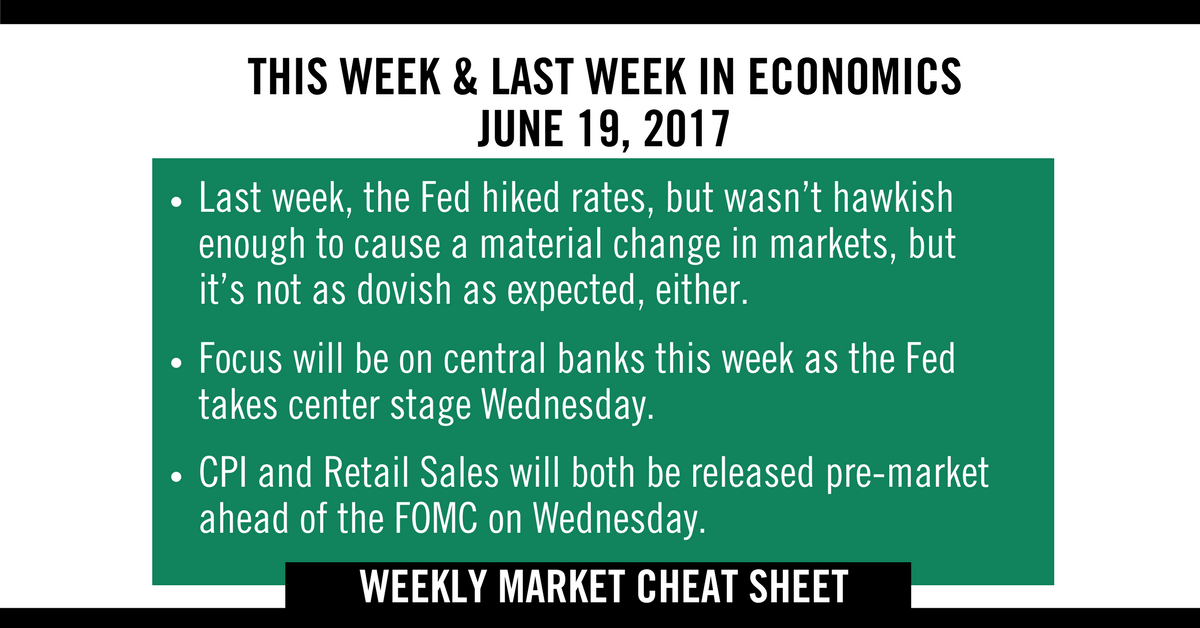Weekly Market Cheat Sheet, June 19, 2017
The Sevens Report is the daily market cheat sheet our subscribers use to keep up on markets, leading indicators, seize opportunities, avoid risks and get more assets. Get a free two-week trial with no obligation, just tell us where to send it.

Last Week in Review:
The Fed hiked rates and gave a not-as-dovish-as-expected statement while economic data (especially on inflation) generally disappointed. In sum, it was a week of underwhelming growth and a slightly more hawkish-than-expected Fed, although in a testament to how resilient stocks have been in 2017 neither the data nor the Fed caused stocks to decline.
Starting with the Fed, there were two distinct takeaways: First, the Fed is staying the course on hiking interest rates, despite underwhelming inflation. That is a hawkish shift from market expectations, as while the Fed acknowledged lower inflation, it doesn’t think it’s enough to change policy. Second, the Fed revealed details of how it plans to reduce its balance sheet (a hawkish exercise), and the surprise came when Fed Chair Yellen said balance sheet reduction (i.e. not reinvesting bond principal payments from years of QE) could start “relatively soon,” which likely means September.
Bottom line, the Fed wasn’t hawkish enough to cause a material change in markets, but it’s not as dovish as expected, either… and we think that’s an important distinction going forward (could be bad for stocks and bonds, so stocks lower/yields higher). From a practical standpoint, market expectations now are for balance sheet reduction to begin in September, and for another rate hike in December.
Looking at the actual economic data last week, it was on balance underwhelming. The positives were the June Empire and Philly Manufacturing Indices. The former exploded to a three-year high while the latter dipped but remained solidly in positive territory at 27.6.
Unfortunately, those positive sentiment indicators were undermined by actual May economic data. The gap between sentiment surveys and hard data remains wide, and a risk to the rally.
First, CPI again missed, as the headline declined to -0.1% vs. (E) 0.0%, and more importantly, if we annualize the last three months gains in core CPI it equals 0.0% for the coming year. That is a far cry from the Fed’s 2% inflation target.
Second, May Industrial Production was a disappointment. The manufacturing sub index dropped to -0.4% vs. (E) 0.2%, and while that decline was driven mostly by a drop in auto manufacturing, and is coming off a strong 1.1% April increase, it’s still not a number that’s indicative of an economy in reflation mode.
It was the same with May Retail Sales. The “control” index (which is the best measure of discretionary consumer spending) was flat in May, although there were positive revisions to April (from 0.2% to 0.6%).
Bottom line, the data is “ok” in an absolute sense, but we’ve definitively lost upside momentum, and we need that to restart if the broad economy is going to power this rally higher
This Week’s Preview:
The key event this week will be Friday’s global flash manufacturing PMIs. Specifically, we need to see if the national number can move higher and provide some needed strong data for the markets. Internationally, there shouldn’t be any surprises, and the PMIs should broadly confirm the global rally is indeed underway.
Outside of the flash PMIs on Friday, there isn’t much on the calendar other than some housing data. Last week’s housing starts data was pretty ugly, frankly, as single family starts dropped 4% while single family permits declined 1.9% (permits lead starts by a few months). So, there will be a bit more focus on the housing data this week. Existing Home Sales comes Tuesday while New Home Sales is released Friday. Bottom line, we need strong data to help contradict the worrisome economic signals in the bond market, and the sooner we get that the better.
Get the simple talking points you need to strengthen your client relationships with the Sevens Report. Everything you need to know about the markets delivered to your inbox by 7am each morning, in 7 minutes or less.


